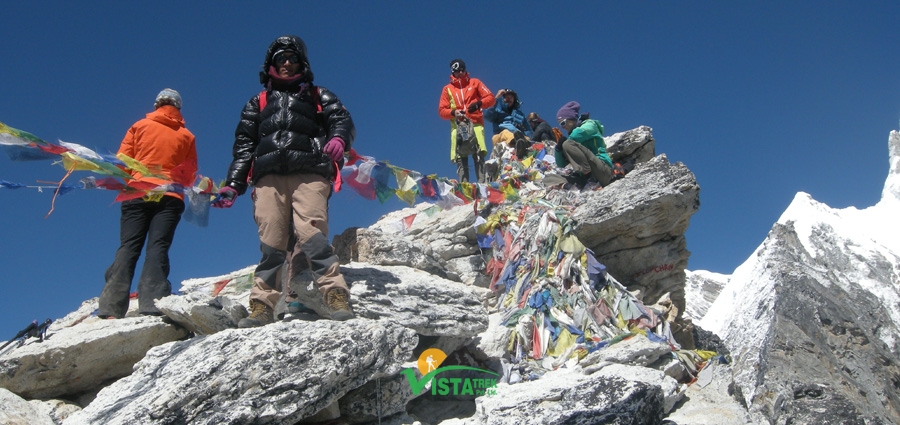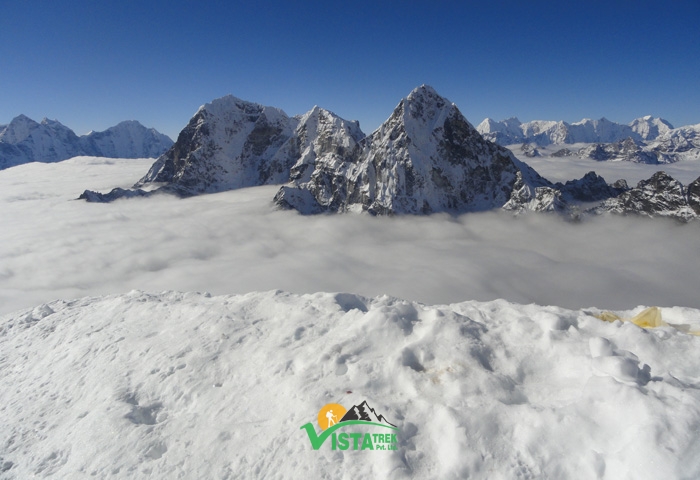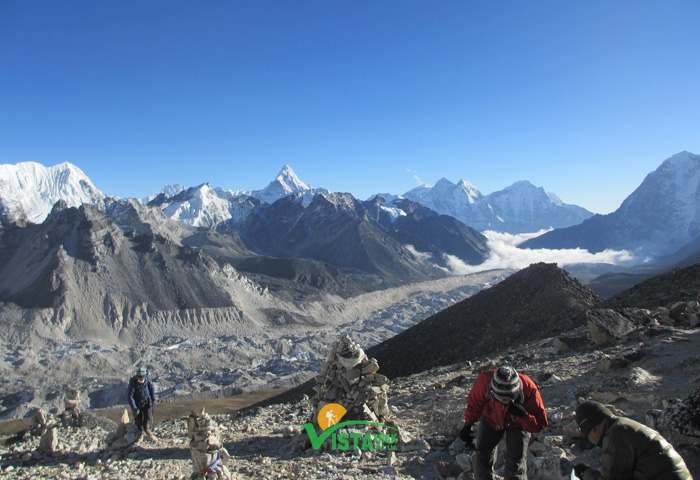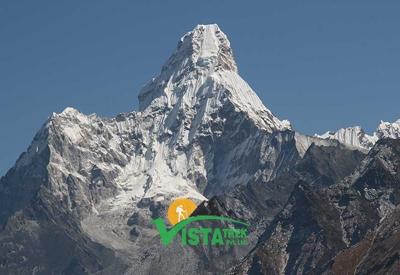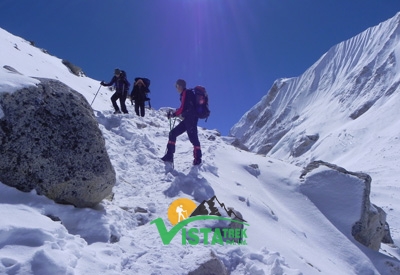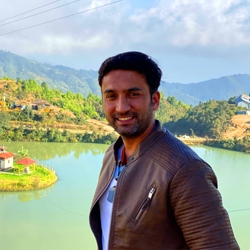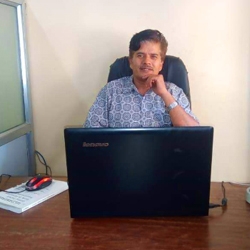Trip Facts
- Duration 62 Days
- Start FromKathmandu
- End FromKathmandu
- Trip GradeEasy
Trip Highlights
- Views of the Everest, Makalu, and Tibetan mountain ranges
- Climb the highest mountain in the world- the Mt. Everest (8848m)
- Enjoy the Sherpa culture and hospitality along the trekking trails
- Explore the natural wonders in the Sagarmatha National Park
Trip Overview
The Everest Expedition is a journey to the top of the world. This Expedition stretches along the Sherpa villages to make way across the Everest Himalayas. Also, the trails on the trek pass through the Sagarmatha National Park and offer a sublime display of scenery. The mix of natural beauty with the ancient culture makes this a remarkable trip. Finally, the euphoric feeling of being at the top of the world caps off the grandeur of the trip.
Like most trips in Nepal, the expedition begins from Kathmandu and heads to Lukla on a short and scenic flight. After a brief rest, you follow the Dudh Koshi River to Phakding. Then, you enter the Sagarmatha National Park and pass Jorsale to reach Namche Bazaar. Here, you spend a day to acclimatize and enjoy the Sherpa culture in action. Further, you follow the Imja River and trek to Tengboche. With the serene views of Ama Dablam (6856m), you continue east to Dingboche. Then, another trek takes you to Lobuche. On this trip, you will also scale the Lobuche Peak (6119m) as a training exercise and make way to Gorakshep. Finally, you trek to the Everest Base Camp and begin the expedition.
The climbers will go on a memorable trip and scale the mountain in the next 34 days. The views of mountains like Nuptse (7861m), Lhotse (8516m), Cho Oyu (8201m), Makalu (8485m), and Kanchenjunga (8586m) will entertain you on the climb. After you complete the climb to the Mt. Everest (8848m), you will descend to Lukla retracing your steps through the national park. You will return to Kathmandu on a short flight and take a tour of the cultural city as well.
Best time for Everest Expedition
Autumn during the months of September and November is the best time for Everest Expedition. Likewise, spring (March to May) is the second-best time for the trip. Needless to say, climbers have to be at the top of their physical and mental shape on the trip.
Note:
At Vista Treks, we offer the finest facilities and services to our clients. Also, we prepare all the necessary permits and documents for your trips in Nepal.
Trip Itinerary
- This day marks your arrival in Kathmandu. Upon arrival, a representative from Vista Treks will meet you outside the Arrivals gate and bring you to your hotel. A short drive will take you through the bustling Kathmandu city.
- After settling the payment due and the paperwork, you can go out to explore Thamel.
- Provide your detail to your Sherpa guide who will then procure the Everest summit permit and other permits.
- You can prepare for the upcoming climb by assessing your climb gear and equipment. Buy or rent climb gear and equipment at any trek stores inThamel.
- You can indulge in a short rock-climbing experience in one of the local rock-climbing stations at Thamel.
- Take an interesting sightseeing tour of the historical Kathmandu city.Explore some of the most popular UNESCO World Heritage Sites such as Pashupatinath, Boudhanath Stupa, and Swayambhunath.
- After breakfast, you will embark on 35-40 min flight from Kathmandu to Luklatown in the Everest Region. The flight will offer a spectacular aerial view of the scenic forested hills, massive river, and snow-capped peaks.
- The trek begins after breakfast at Lukla. The first day of the trek spans 3-4hr and covers almost 11km from Lukla to Phakding Village.
- Begin walking comfortably through small Sherpa settlements alongside DudhKoshi River. Observe the beautiful Sherpa settlement and unique architecture.
- Enjoy your breakfast basking in the morning sun just outside your hotel.
- The trek begins with a comfortable uphill walk towards the high-suspension bridge. Cross the bridge and arrive at Monjo Village. Monjo is a Sherpa village that marks the entrance to theSagarmatha National Park. This Himalayan national park was inscribed into the UNESCO World Heritage Site list in 1979.
- Obtain the entry permit and continue walking through the park to reach Namche Bazaar.
- Namche Bazaar, overlooking the beautiful KongdeRi Peak (6187m), is the largest Sherpa village in the entire region.
- After 5-6hr of the trek, you will arrive at Namche. You can spend the evening exploring the Bazaar.
- Enjoy the day exploring the beautiful Sherpa village and observe the unique lifestyle, culture, and occupation of the locals.
- After breakfast, you will embark on a short hike towards Khumjung Village. Walkthrough the main Bazaar and head east towards Khumjung village.
- Khumjung village (3790m) is home to Khumjung Monastery that remains a popular tourist attraction for its well-preserved Yeti scalp inside a glass box.
- Leave the monastery, and continue walking towards Hillary School, the largest school in the Everest region. You will get to walk past the potato fields and Syangboche Airstrip en route to the school.
- After exploring the school, you’ll begin trekking downhill towards Namche Bazaar for the overnight stay.
- After a full day of acclimatization, you’ll begin ascending uphill and trek all the way to Tyangboche. The trail continues alongside DudhKoshi River and goes past the lushly forested path to arrive at Tyangboche.
- En route to Tyangboche, you’ll arrive at PhungiThanga that offers the beautiful sight of AmaDablampeak.
- Tyangboche Village (3860m) is home to the popular Tengboche Monastery. It is the highest Buddhist monastery in the region, known for hosting the annual Mani Rimdu festival that attracts a large number of locals and tourists.
- In the morning, you’ll visit Tengboche Monastery. Explore the vicinity and prayer halls. You get to meet the local monks inside the monastery and interact with them.
- Afterward, you’ll begin trekking north towards Debuche village. Upon cross the ImjaKhola, you’ll arrive at Pangboche Village that remains popular for thousands of Mani stones decorated along the trail.
- Enjoy the scenic sight of mani stones, prayer flags and graffiti walls en route to Dingboche, a traditional Sherpa village.
- Leaving Dingboche Village, you’ll continue trekking towards Lobuche Village. Lobuche is a small Sherpa settlement located just below the hanging ridge of Lobuche Peak.
- The trek may last about 6 to 7 hours and takes you through Thukla where you will find a climber’s memorial park.
- Once at Lobuche, you will find the exciting view of the entire Khumbu glacier, Lobuche peak, Mt. Pumori, and Mt. Nuptse.
- Lobuche lies at the intersection between Lobuche peak and the Everest Base Camp trail.
- An essential day will be spent at Lobuche village acclimatizing before approaching Lobuche Peak.
- You can go for a short hike outside Lobuche.Walk along the snow moraines overlooking the majestic Lobuche East Peak.
- You can also rent needed gear and equipment at Lobuche village before embarking for the climb.
- Leaving Lobuche Village, you’ll embark on a short trek towards Lobuche Base Camp.
- The short trek will be easy as you cover the flatter plane along the snow moraines towards the steeper and rocky path that leads directly towards Lobuche Base Camp.
- Enjoy the beautiful sight of Lobuche Glacier and the nearby peaks such as AmaDablam, Cholatse, Pokalde, Thamserku, and Kantega.
- Overnight inside a tented camp.
- Today, you’ll spend the day preparing and acclimatizing for the climb. The staff will prepare your meals.
- Your Sherpa guide will provide you with handy training and tips on peak climbing techniques such as the right use of ice-ax, ascender, climbing boots, crampons, harness, and carabiner.
- A short climb will follow afterward, where you’ll get to practice alpinism firsthand. This training will also help you later when climbing Everest Peak.
- Overnight in a tented camp.
- After breakfast, you’ll leave Lobuche Base Camp and embark on a short trek/climb towards Lobuche High Camp.
- The trail continues through a rocky moraine and climbs the rock surface for up to an altitude of 5440m. You will begin using ropes to climb on the ice and snow terrain. The use of rope will depend on the time of the year (season) and the number of crevasses in the area.
- Enjoy the majestic sight of AmaDablam, Cholatse, Pokalde, and Thamserku peaks en route to High Camp.
- Overnight inside a tented camp.
- You will wake up before dawn and prepare for the climb. Depending on the weather condition, your guide will suggest if you should stay put or attempt the climb.
- After breakfast, at around 2 am, you’ll begin climbing the rock surface up to around 5770 meters. (An early summit ensures good weather condition).
- Here on, you’ll begin ascending the ice wall using the fixed rope and ice-ax wherever necessary. Before approaching the final ascent, you will meet a challenging exposed ridge.
- From the top, you can enjoy the beautiful view of the entire valley along with some of the highest mountains on Earth.
- The 5-6hr trek will cut short, and you will begin climbing down the peak to arrive at Lobuche Base Camp.
- The night will be spent inside a tented camp at Lobuche Base Camp.
- After breakfast, you’ll leave Lobuche Base Camp and continue through the moraines towards Lobuche Village. It may take over 3hr to arrive at Lobuche.
- After lunch, you’ll set on your regular path and continue trekking north towards Gorakshep Village.
- The distance from Lobuche to Gorakshep remains short. Spend the rest of the day relaxing inside your teahouse and drink warm fluid to keep yourself hydrated.
- Leaving Gorakshep, you’ll begin trekking towards Everest Base Camp.
- You’ll begin trekking through rugged terrain and climb the trail alongside Khumbu Glacier towards the rocky Base Camp destination.
- The entire trail spans a mere 3.5km.However, you’ll take it slow and take enough rests in between.
- Once at the base camp, you can explore the nearby Khumbu Glacier and approach towards Khumbu Icefall before retreating to the climber tent.
- Spend a few days at the base camp before attempting for the climb. You will meet other fellow climbers and train for the climb with your Sherpa guide.
- A handful of days will be spent resting and acclimatizing at the Everest Base Camp.
- You will be provided with a separate kitchen and restroom. We’ll ensure that you get the best and luxurious service during your stay at Everest Base Camp.
- You will have access to satellite phone service for communication, Wi-Fi and hotspots for the internet.
- Hot showers will be available.
- Your training will begin.Your guide and other staff will help you prepare for the rigorous climb.
- The training is mostly focused on the safe ascent, walking/climbing ladders, crossing crevices, using rope, ice-ax, and carabineer for an effective climbing experience
- The foremost of all of these training includes icefall training.
- The climb begins with an ascent to Camp I. It is a difficult part of the journey as you would need to cross Khumbu Icefall that is prone to many accidents due to huge openings and crevices. You will acclimatize at the same time as you make your way up. After a lengthy 5hr trek over the loose ice, you’ll climb a ladder and ropes to finally arrive at camp I.
- From Camp I, you’ll approach Camp II. The climb continues through the silent valley that opens up the rocky path just beside the Lhotse Wall. Camping close to the wall is generally avoided because of the avalanches. You will spend time acclimatizing at Camp II.
- Leaving Camp II, you’ll begin climbing towards Camp III. The trail remains comparatively safe and exciting as you approach Camp III. The trail here on is marked potentially dangerous. It is important that you keep yourself hydrated and assess your health frequently for signs of AMS.
- You’ll approach the South Col, the sharp-edged notch located between Mount Everest and Lhotse Peak. The open section is where you’ll establish your Camp IV. This is the usual route for all the climbers attempting Everest summit through Southeast ridge.
- Using artificial oxygen, you’ll begin climbing the rough path that leads directly to the summit. The true summit of Everest is not visible from South Col. It lies 1.07 miles from Camp IV. The final ascent begins early morning as you continuously climb for 6-9hr to arrive at Hillary step.
- Crossing the dangerous Hillary Step, you’ll make the final steep ascent of the peak and arrive at the top from where you can enjoy the once-in-a-lifetime view of the nearby mountains. In your front is Nepal, while Tibet lies at your back. After spending a brief time, you’ll begin descending all the way back to Camp IV.
- The climb continues through Camp III and Camp II to Camp I. The final descent goes past Khumbu Icefall towards Everest Base Camp.
- Leaving Everest Base Camp, you’ll begin trekking all the way back to Dingboche.
- Walk past Gorakshep and Lobuche en route to Dingboche village.
- Catch the beautiful sight of Mt. Lhotse en route.
- After breakfast, begin climbing down and arrive at the traditional Pangboche Village. You can choose to visit the Pangboche Monastery before heading down towards Debuche Village.
- Cross ImjaKhola and arrive at Debuche. Enjoy a lavish lunch followed by a short uphill hike towards Tyangboche.
- Overnight in Tyangboche Village.
- The trail becomes easier as you begin descending towards Namche Bazaar.
- Walk past PhungiThanga en route to Namche.
- Spend the evening enjoying the vibrant lifestyle of the tourists at Namche Bazaar.
- On the last day of the trek, you’ll begin climbing down toward Monjo Village overlooking the beautiful KongdeRi Peak.
- At Monjo, you’ll exit Sagarmatha National Park. Continue heading downhill towards Phakding. A short downhill hike along with DudhKoshi River will bring you to Lukla.
- Celebrate the completion of the trip with your colleagues and staff.
- You’ll exit Everest Region and embark on a short flight from Lukla to Kathmandu.
- Catch the aerial sight of the lush forested hills and few Himalayan Peaks from the flight.
- Check into your hotel. Afterward, you can choose to go out and explore the city or simply relax in your hotel.
- As a leisure day, you can choose to relax at the hotel or embark on a city tour.
- Visit some of the popular UNESCO World Heritage Sites located in and outside Kathmandu City such as Patan Durbar Square and Bhaktapur Durbar Square.
- Indulge in a relaxing trekkers’ massage at Thamel.
- Enjoy your breakfast at the hotel.
- Depending on your flight timing, we’ll drop you off at Tribhuvan International Airport.
Cost Includes
- Pick up and drop from Airport –Hotel-Airport.
- Deluxe hotel accommodation in Kathmandu with breakfast.
- An English speaking guide, cook, porter, Sherpa and helper boy
- Full board of meals during the trek & camping at base camp, prepared by our cook with hot Tea & coffee.
- Insurance for all Nepali staffs and porters including helicopter rescue provision.
- Expedition permit, National park fees and Garbage deposits.
- Liaison officer and his round trip flight, insurance, wages, expedition equipment etc.
- A portable hyperbaric chamber (Gamow bag)
- Oxygen equipment for medical use only.
- A well stocked first aid and medical kit sufficient to counter any possible mountaineering ailments, from headache to serious injury.
- Oxygen 6 bottles per team climber and 4 bottles per Sherpa.
- Mask regulator
- Emergency communications on the mountain and satellite communications link for helicopter evacuation. (Personal calls subject to charges at US$ 3 per minute)
- High quality tents for all camps.
- Boiled and purify drinking water for the trek and at base camp.
- Flight fare from Kathmandu to Lukla and from Lukla to Kathmandu
- Farewell dinner party in Kathmandu
- Climbing Sherpas (1 member = 1 Sherpa Ratio on climbing day)
- High altitude climbing food, fuel, Gas above base camp (you are also advised to bring some high altitude food yourselves)
- All base camp and Advance base camp camping gears
Cost Excludes
- Lunch & dinner in Kathmandu Hotel
- International airfare
- Nepal entry visa fee, which can be obtained at the airport upon arrival {bring 4 copies passport size picture too}
- Alcoholic beverages , bottle mineral water, soft drinks and snack foods
- Personal climbing gear above advance base camp
- Personal insurance such as travel, accident, medical, emergency evacuation and lost luggage
- Overstay in Kathmandu Hotel as per itinerary
- Tips and Bonus to our staff




